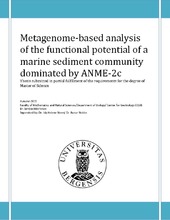Metagenome-based analysis of the functional potential of a marine sediment community dominated by ANME-2c
Master thesis
Permanent lenke
http://hdl.handle.net/1956/10696Utgivelsesdato
2015-10-26Metadata
Vis full innførselSamlinger
Sammendrag
Methane is the most abundant hydrocarbon in the atmosphere and after CO2; it contributes for 14% of global greenhouse gas emissions. Marine sediments are a large reservoir of methane where approximately 80% of the methane is formed through a biological process known as methanogenesis by methanogenic archaea. Despite the high rates of CH4 production in marine sediments, about 90% of methane flux from sediment is recycled through the microbial process, anaerobic oxidation of methane (AOM) with sulfate. The AOM is catalyzed by uncultivated anaerobic methanotrophic archaea (ANME-1, 2 and 3) which thus have a crucial role regulating the flux of methane from marine environments to the atmosphere. In this study, the functional potential of an ANME2c-dominated sediment horizon at 20-22cm below the seafloor in the G11 pockmark at Nyegga has been investigated using a metagenomic approach. Total DNA was applied to 454-pyrosequencing and 142.8 MB (1001981 sequence reads) sequence information was assembled into 22706 contigs. The assembled contigs were clustered into 4 bins based on multivariate statistics of tetra-nucleotide frequencies combined with the use of interpolated Markov models, using Metawatt binner tool. Three of the metagenomic bins were imported into RAST for annotation. From the bins, genes encoding phylogenetic marker genes, 16S rRNA, Adenylylsulfate reductase (AprAB) and Methyl CoM reductase (Mcr) subunit A (McrA) were extracted. Phylogenetic analysis suggested that metagenomic bin II was of ANME2c and bin I was of Desulfobacteraceae. A complete set of genes encoding enzymes involved in reverse methanogenesis including Coenzyme F420-dependent N5N10-methylene tetrahydromethanopterin reductase (Mer) and Methyl CoM reductase (Mcr) was observed in the ANME2c bin. In the Desulfobacteraceae bin, the enzymes involved in three enzymatic reactions of the dissimilatory sulfate reduction pathway, Sulfate adenylyltransferase (Sat), Adenylylsulfate reductase (AprAB) and Dissimilatory sulfite reductase (DsrABC) were identified. Furthermore, the electron transporter proteins, QmoABC (quinone-interacting membrane-bound oxidoreductase) and DsrMJKOP complexes known to donate electron to AprAB and DsrABC, respectively, were found in this bin. The presence of CO-dehydrogenase/acetyl-CoA synthase (Fd2−red), the key enzyme of acetyl-coenzyme A (CoA) pathway, in the Desulfobacteraceae and ANME-2c bins indicated a potential for CO2 fixation via this pathway in both groups of microorganisms. The obtained data did not reveal any information about substrate spectrum by the Desulfobacteraceae as no genes encoding an uptake hydrogenase, formate dehydrogenase and lactate dehydrogenase were identified. The metagenomic analyses did not support the use of other electron acceptors like nitrate of iron/manganese by the ANME2c population. However, the presence of gene fragments of a nitrogen fixation pathway in methanogenic archaea in the metagenomic data indicated a potential for this process in the community. Altogether, this study has fortified the partnership of ANME-2c and sulfate-reducing bacteria from the Desulfobacteraceae family, and revealed new information about other possible aspects of syntrophy, in addition to the methane oxidation coupled to sulfate reduction, in the Nyegga sediments.
